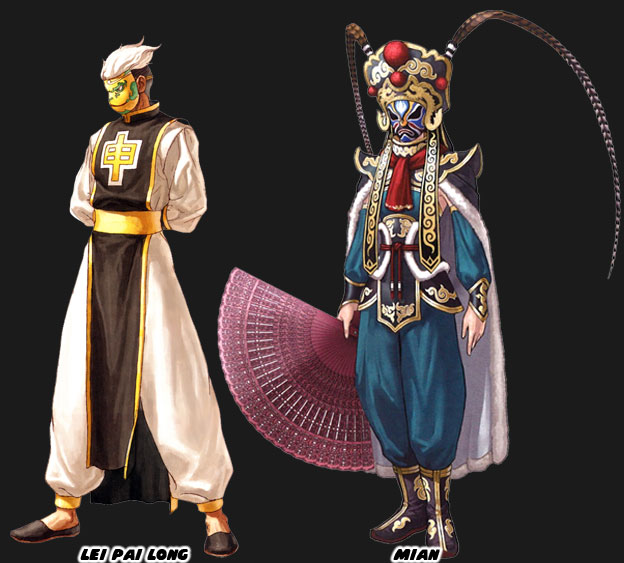
Lee was a mysterious figure, his actual face was known only by a few people in King of Fighters continuity. As memorable as the character was, he didn't work well enough to be used as often as some other fighters. The seeds however had been planted to include the traditional costumed fighter from time to time. Almost 25 years later the studio went back to the classics and introduced another masked Chinese character. Mian was not a representative of the Chinese team in the KOF series, she was instead a member invited by tournament organizer Antonov. The dancer and master of the Chinese art of mask changing, was breaking down stereotypes. Her Sichuanese Opera costume was traditionally worn by male actors and even the historic mask changing magic was performed almost exclusively by men. SNK had become more attuned to the Chinese consumer over the past few years. Chinese gaming had exploded in popularity the past decade and every major studio was trying to make headway into the Chinese market. SNK had even partnered with Shanda, one of the largest publishers, to get a KOF massively multiplayer online (MMO) game launched. They were paying closer attention to the growing markets than just about any other fighting game publisher had in the past few years. After facing a few financial crisis, a merger with Playmore and restructuring, SNK had to ensure that they made business savvy moves. This wasn't the case when they originally fleshed out the Chinese team or even Brazilian team in KOF '94.
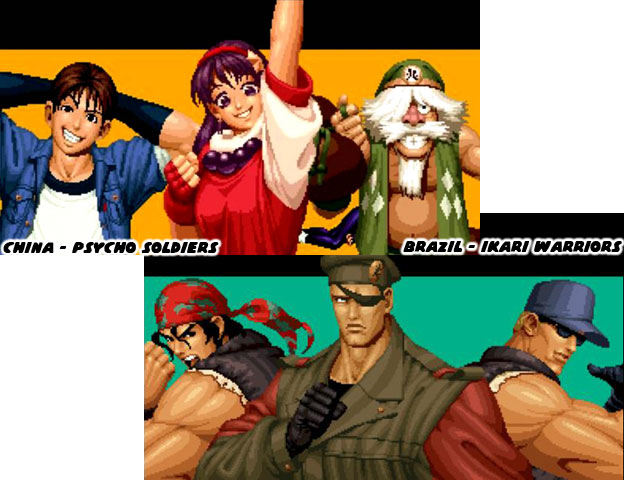
SNK wanted to create a sense of a global competition in the KOF series, the only problem was that they lacked familiar characters from each nation. To circumvent this they relied on characters from other games to act as representatives of a country. The Chinese team of Athena Asamiya and her partner Sie Kensou for example were pulled from the game Psycho Soldier. They were not necessarily fighters trained in a specific named form. The two relied instead on psychic attacks to supplement their martial arts training. The third Chinese representative, Chin Gentsai, was modeled after the "Drunken Master" a movie character named Beggar So played by Yuen Siu-tien. The three barely had a thread that connected them to China. How do you think that Chinese audiences reacted to the characters? The same thing could be observed with the Ikari Warriors, Ralf Jones and Clark Still. The two had appeared in an action shooter set in the jungle but it was not known if they, or team captain Heidern, were actually from Brazil. The three were mercenaries and didn't represent any school of Brazilian martial arts. More than 20 years later SNK had become more attuned to their audiences. The Japanese publishers (Capcom included) were surprised to learn how popular their games were in Central and South America. The Brazil Game Show for example had more than 300,000 attendees in 2017! Because of this the designers took a little more time in crafting new characters for the King of Fighters XIV. Nelson the boxer was from Brazil. I had mentioned previously in this series, but he was joined by two new Brazilians as well.
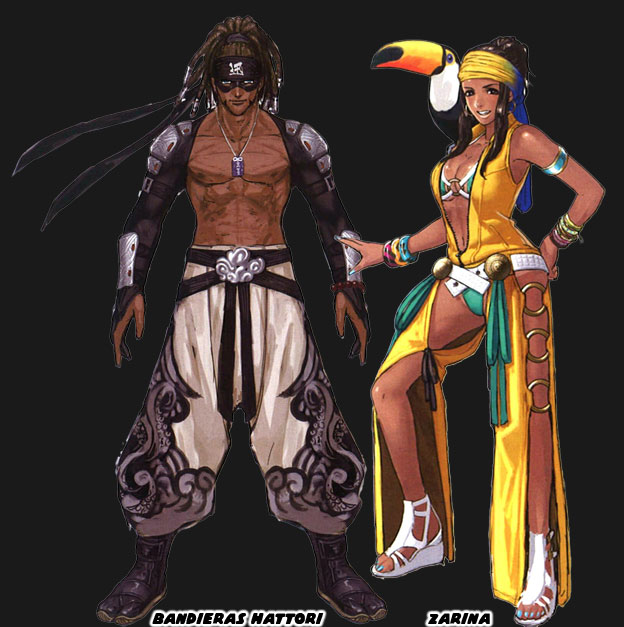
The masked Bandieras Hattori was obsessed with ninjitsu. He idolized Andy Bogard and Mai Shiranui and wanted to become a full-fledged ninja. His ultimate goal was teaching his own form of ninjitsu in Japan. His dark skin, armor and light pants, with sumi-e waves painted on the cuffs created some incredible contrast. His mask and pulled up braided hair made him appear unlike any other modern fighting game character. The character could be seen as an homage (or even parody depending on your perspective) of how passionate South Americans were about Japanese culture. The third new character was Zarina. She sported the colors of the Brazilian flag and most assumed that she would be a capoeirista. Despite her ginga, or dancing stance, she was actually a samba dancer that happened to be a good fighter. It was strange that the new developers would focus on her dance more than the martial arts. Capoeira had been a part of the SNK legacy since Street Smart back in 1989. Richard Meyer and Bob Wilson were two of the more famous Capoeira stars from the Fatal Fury series. I had talked about the origins of Capoeira in fighting games on a previous blog. I don’t understand why the newer generation of SNK developers would have missed this connection to their actual legacy. To be fair I think that many of the Street Fighter IV and V designs also failed to live up to the legacy designs. But I digress. The mix of new Brazilians was a unique choice, not quite the masters hidden in plain sight but perhaps something the studio could build on and learn from. Just like Heavy D was a change in direction for boxers, I’m certain that Bandeiras, Zarina and Nelson were the start of a new direction as well.
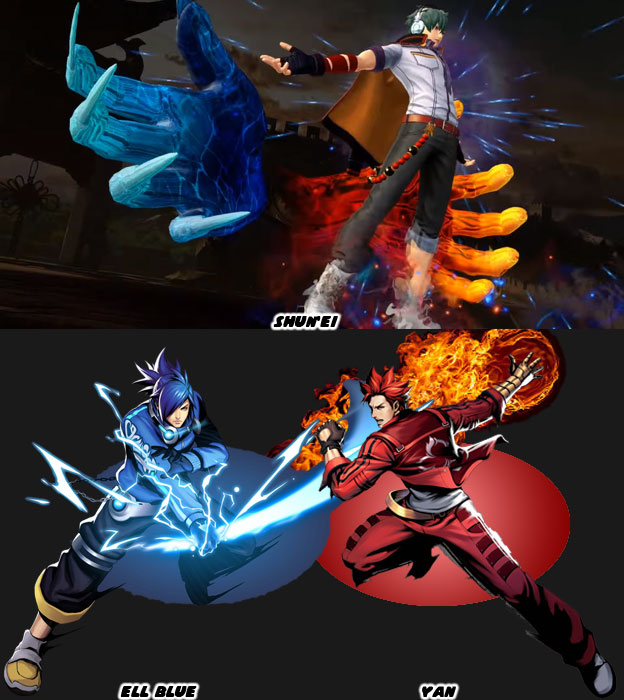
What really surprised me for the new characters in KOF XIV was the Chinese star Shun’ Ei. The design was pandering very heavily to what some Chinese gamers thought made a cool design. Many in the community saw the character as even poaching the design of a couple of characters from Xuan Duo Zhi Wang / the King of Combat. To be fair I had also brought up that fighting games had been stealing things from each other as much as from pop culture for over 30 years. When the Japanese studios did it nobody seemed to mind but when Chinese developers began doing it then suddenly audiences were in an uproar. If anything Shun’Ei was reinforcing the themes that many Chinese audiences favored in the character designs. King of Combat focused on martial arts masters in plain clothes, their inspirations were pulled from post KOF ’94 stars. Terry Bogard was probably the first plain clothes master in a franchise but it was Kyo Kusanagi that redefined the look. From that point going forward the characters in KOF didn’t even need a named fighting art. They could be dressed in trendy fashion and have psychic or elemental powers at their disposal. Ell Blue and Yan were distilled from that understanding.
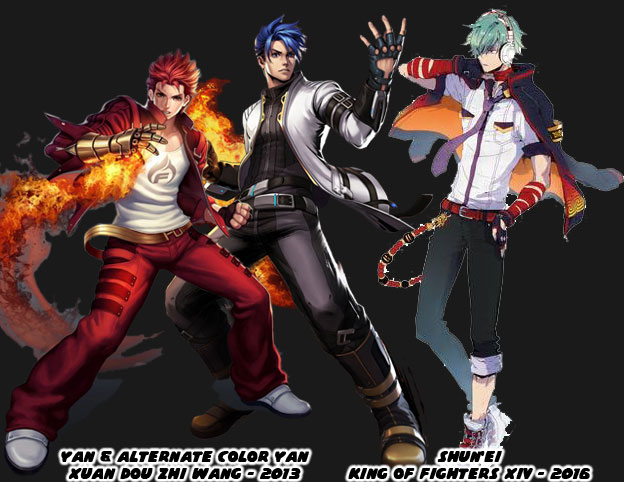
Kyo Kusanagi, Iori Yagami, Shen Woo and Ash Crimson were some of the templates that the designers from Jade Studio were working from. The majority of the cast was supposed to look cool and trendy and there was no better studio to borrow from. The Chinese developers built a 3D fighter that was presented in 2D so that it played like a classic arcade fighter. They recreated all the elements found in latter KOF games, going so far as to capture the feel of SNK’s level and stage designs. They even sprinkled in elements from Street Fighter and Tekken as well to make a terrific mash-up for the PC. The artists working on the game knew enough of the origins behind characters like Kyo and Iori when they created their stars Ell Blue and Yan. The former being more western-themed and the latter being closer to the East. In case you weren’t familiar Kyo and Iori from the KOF series had costumes that were rooted in high school uniforms. The cut of their clothing was a little bit more fashionable, making them really stand out among the rest of the KOF lineup. Ell Blue had a certain Western hip hop flair to his design, sporting bright blue hair, headphones, and even a rolled up pant leg. He looked like a super producer, a DJ-turned-fighter. Yan had more of the high school uniform mixed with a belt and other stylist accessories.
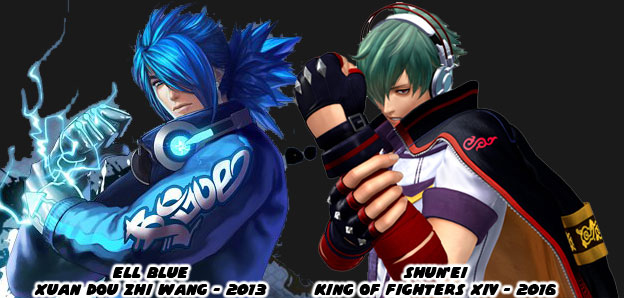
When Shun’Ei was unveiled his design was so familiar it was uncanny. It was as if the designers at SNK took both Ell Blue and Yan and combined them into one character. There were the elemental powers, fire and electricity, but there was also the strong red and blue theme to accompany those powers. Then there was the costume itself. Part school uniform, with stylish belt, accessories, headphones and rolled up pant leg. There were too many elements brought in to be more than coincidence. They were reflecting back to the Chinese what they assumed they wanted to see in the star of their team. It wasn’t necessarily a case of the Japanese artists copying the Chinese. The publisher of King of Combat, Tencent, was one of the biggest publishers in the world, and they even licensed some KOF stars to appear in their game. There was a good chance that some of the Jade developers helped program or design some of the new faces in KOF IV. Of course only SNK could confirm or deny that observation. Regardless, the company had been at the forefront of fighting game development for almost as long as the genre had existed. Budding developers hoping to capture that SNK-style need to understand why their characters are unlike those in Capcom, Namco, or any other studio. They managed to hide the fighting master in plain sight. Remember this the next time a new character is announced for the series. Now there were two other characters on the new Team China. But I'll talk about them some other day. As always if you enjoyed this blog and would like to sponsor me please visit my Patreon page and consider donating each month, even as little as $1 would help make better blogs and even podcasts!

Zarina being heavily influenced by Brasil despite having her nationality listed as Colombia and the whole being called "South American Team" instead of being "Brasilian" team seemed to cause a lot of annoyed people who lived elsewhere in SA. Is that an error in making a global appeal?
ReplyDelete